|
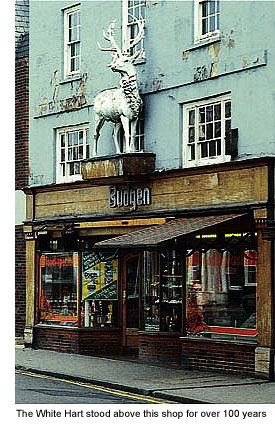 An alehouse called the Dog and Bear stood on this site from 1659–1684, the name being an allusion to the popular 'sport' of bear bating that was fashionable in that period – though probably not in Bishop’s Stortford. The narrow lane alongside the alehouse was aptly named Dog and Bear Lane but this later changed to Cross Street, then Dodd's Lane. It was renamed Barrett Lane in the 1930s in memory of Alfred Slapps Barrett. An alehouse called the Dog and Bear stood on this site from 1659–1684, the name being an allusion to the popular 'sport' of bear bating that was fashionable in that period – though probably not in Bishop’s Stortford. The narrow lane alongside the alehouse was aptly named Dog and Bear Lane but this later changed to Cross Street, then Dodd's Lane. It was renamed Barrett Lane in the 1930s in memory of Alfred Slapps Barrett.
In the late 1600s the Dog and Bear was converted for use as a wine and spirit merchants and in the early 1800s became the site of James Hillatt Summers's print shop, which was also the town post office. Summers was postmaster from 1816–1841 (See No 17 North Street – Pearsons).
In 1867 the property became Dodd & Burls grocery shop. They sold out to the partnership of Holland & Barrett in the late 1800s and in the 1920s the surviving partner, Alfred Slapps Barrett, sold out to Messrs Alfred Button & Sons. They kept the familiar name of Holland & Barrett above the door but when Bookers bought them out in the early 1970s the name was changed to Budgens. The shop frontage was also altered at this time.
In 1986 the property was bought by Midland Bank – now HSBC – who for many years had occupied No 38 North Street at the corner of Water Lane. They demolished the property, but so as not to spoil the historic architecture of North Street (as was the case with the building of Lloyds Bank) the frontage was constructed to replicate the building it replaced. Beyond the entrance door, though, everything is suited to the 21st century. The bank opened in 1987.
During the First World War the grocery shop's previous owner, Alfred Slapps Barrett, upset local people by giving a consignment of flour, destined for sale in his shop, to the PoW camp at Oak Hall (See Chantry Road – Guide 5). Whether it was a gift or a business transaction isn’t known but afterwards disgruntled residents daubed his shop windows with a variety of hostile slogans.
Long after this incident had been forgotten the shop once again became extremely popular with locals, especially at Christmas time when the annual wine tasting took place. This event was held (by invitation only) in the galleried coffee shop on the first floor, but was finally abandoned when one year the floor began to move due to weight of numbers and rotting timbers. The shop is also remembered for coffee being milled and roasted on the premises, the aroma pervading the whole street with that inviting smell that only coffee has. MORE PICTURES
|
|
Built around 1971 by former local builders J A Elliotts Ltd, Lloyds Bank is North Street’s most modern building and does seem a little out of place among its elders. An earlier property on this site was owned by Thomas Bradfield (printer), who died in 1871, and then by a butcher named Thomas Edridge who shared the shop frontage with another butcher named Fowler. He later bought the property from Edridge, demolished it, and then replaced it in 1889 with a new building that included bay windows on the first floor. Most importantly though, the building was designed to include an open fronted shop where poultry and meat could be displayed, which at Christmas time would cover the entire frontage up to first floor level (see photograph). At a later date the upper floor became home to a doctor's surgery. The property was then bought by a Mr Swain and later became Groves Builders Merchant. Demolition in 1970 made way for Lloyds Bank, previously housed in part of the Corn Exchange.
Lloyds have had a presence in the town since 1918, at that time taking over Capital & Counties Bank, which in 1904 had absorbed Messrs Foster & Co established at Market Square in 1874.
The building next to the bank was erected in 1888, as shown in the terracotta-moulded brickwork high up on the gable. MORE PICTURES
|
|
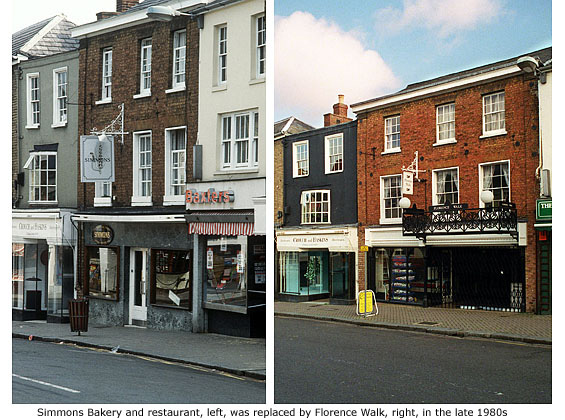
The Six Bells Inn traded on this site (and also that of No 30, Crouch & Haskins) between 1671 and 1778, but was later converted into tenements. Close by, another premises called The Fish was recorded in 1782, although it isn’t known if this was a shop or a public house.
Florence Walk is a modern shopping arcade linking North Street with Water Lane, built in the late 1980s to replace Simmons Bakery and Restaurant, as well as Simmons Ballroom. Both bakery and restaurant were established here long before the ballroom was built in 1920, which was first named Long's after its owner Johnny Long. Boasting a sprung maple dance floor and the capacity to hold 500 people, it soon became Bishop's Stortford's social mecca.
The wartime years at Long's were particularly memorable after the Americans arrived here in 1942 – Saturday night dances becoming a regular and popular event for cementing Anglo-American relations. After the war, Long's reverted to being used for gala nights, wedding receptions and various other social functions, but its popularity gathered pace in 1958 when the Mitre Jazz Club took up residence (See Guide 13 – Holy Trinity Church Hall).
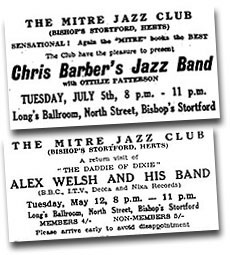 Traditional/revivalist jazz was the popular music at that time and many local bands, as well as some of the more famous, played at Long's on a regular basis. One of the first bookings in 1958 was the Mick Mulligan Band, whose larger than life vocalist George Melly went on to become a popular writer and broadcaster.
Traditional/revivalist jazz was the popular music at that time and many local bands, as well as some of the more famous, played at Long's on a regular basis. One of the first bookings in 1958 was the Mick Mulligan Band, whose larger than life vocalist George Melly went on to become a popular writer and broadcaster.
That same year, Long’s saw the appearance of Wally Fawkes and his newly formed band, the Troglodytes. Wally, perhaps best remembered for his cartoon character ‘Flook’ that for many years appeared in the Daily Mail, used the pseudonym ‘Trog’ for his drawings and extended it to form the band’s name. A talented musician, he played with the Humphrey Lyttleton Band before forming The Troglodytes in 1956.
Other notable names from the world of jazz who played here were: Alex Welsh and his Band; The Temperance Seven; Acker Bilk and his Paramount Jazz Band; Terry Lightfoot’s New Orleans Jazzmen; Kenny Ball and his Jazzmen; Ken Colyer’s Jazzmen and Humphrey Lyttleton.
The Mitre Club became one of the most popular venues to play on the jazz musician’s circuit, but by the early 1960s Rock ‘n’ Roll was rapidly coming to the fore. Realising the change in musical taste the Mitre Jazz Club’s committee decided to call it a day and, after five years of unparalleled success, closed the club on 18 December 1962.
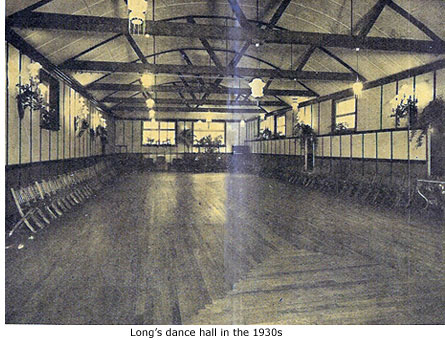 Prior to this date Long’s management had already tested the water by booking Rock ‘n’ Roll bands, and lost no time in starting up the Hop Club. During the next two years locals were regularly entertained by a number of emerging bands, many of whom went on to experience much greater fame.
Prior to this date Long’s management had already tested the water by booking Rock ‘n’ Roll bands, and lost no time in starting up the Hop Club. During the next two years locals were regularly entertained by a number of emerging bands, many of whom went on to experience much greater fame.
Some of the better known names who played here were: Manfred Mann; Chris Farlow and the Thunderbirds; Screaming Lord Sutch; Ricky Valance; Brian Poole and the Tremeloes; Shane Fenton and the Fentones; The Barron Knights and, in 1964, Paul Raven and the Twilights. Paul Raven became better known as Gary Glitter in the 1970s.
Although no ‘recorded’ evidence exists, other well known groups thought to have played here in the 1960s were: The Applejacks; The Dave Clark Five; The Honeycombes; Johnny Kidd and the Pirates, and The Swinging Blue Jeans.
In 1963 Long’s unrivalled success as the town’s premier venue for live entertainment was challenged by the newly built Rhodes Centre at South Street (See Guide 13). Geographically, it was far more accessible to people from out of town using public transport, and with modern facilities it held far more appeal than the ageing Long’s Ballroom.
After a shaky start the Rhodes Centre rapidly became ‘the’ venue for pop groups to play, while Long’s, unable to compete, saw a massive fall in bookings and slid deeper into debt. By the mid 1960s Long’s still managed to put on a few live bands, but by now had more or less reverted to its beginnings – catering for social functions.
Although Simmons bought Long’s Ballroom in the late 1970s and continued to hire it out for social functions, they eventually sold all their interests here in the late 1980s. The only part of the original building to remain is above the entrance to Florence Walk.
• Far more can be learned about Bishop's Stortford's music scene in ‘The Day Before Yesterday’ by Steve Ingless – available in all local bookshops.
No 38: This was once the site of Clarke & Kelsey's Ladies School, demolished in the 19th century to make way for Hawkes & Co Brewery offices. Their building was later occupied by Midland Bank, who moved out in 1897 to new premises at No 18 North Street.
No 40: This property was also used by Hawkes brewery as offices, and between 1861 and 1868 by local architect George Pritchett (See Guide 5 – Chantry Road). Midland Bank later extended No 38 sideways into No 40. MORE PICTURES
|

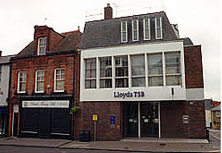


 An alehouse called the Dog and Bear stood on this site from 1659–1684, the name being an allusion to the popular 'sport' of bear bating that was fashionable in that period – though probably not in Bishop’s Stortford. The narrow lane alongside the alehouse was aptly named Dog and Bear Lane but this later changed to Cross Street, then Dodd's Lane. It was renamed Barrett Lane in the 1930s in memory of Alfred Slapps Barrett.
An alehouse called the Dog and Bear stood on this site from 1659–1684, the name being an allusion to the popular 'sport' of bear bating that was fashionable in that period – though probably not in Bishop’s Stortford. The narrow lane alongside the alehouse was aptly named Dog and Bear Lane but this later changed to Cross Street, then Dodd's Lane. It was renamed Barrett Lane in the 1930s in memory of Alfred Slapps Barrett.
 Traditional/revivalist jazz was the popular music at that time and many local bands, as well as some of the more famous, played at Long's on a regular basis. One of the first bookings in 1958 was the Mick Mulligan Band, whose larger than life vocalist George Melly went on to become a popular writer and broadcaster.
Traditional/revivalist jazz was the popular music at that time and many local bands, as well as some of the more famous, played at Long's on a regular basis. One of the first bookings in 1958 was the Mick Mulligan Band, whose larger than life vocalist George Melly went on to become a popular writer and broadcaster. Prior to this date Long’s management had already tested the water by booking Rock ‘n’ Roll bands, and lost no time in starting up the Hop Club. During the next two years locals were regularly entertained by a number of emerging bands, many of whom went on to experience much greater fame.
Prior to this date Long’s management had already tested the water by booking Rock ‘n’ Roll bands, and lost no time in starting up the Hop Club. During the next two years locals were regularly entertained by a number of emerging bands, many of whom went on to experience much greater fame.